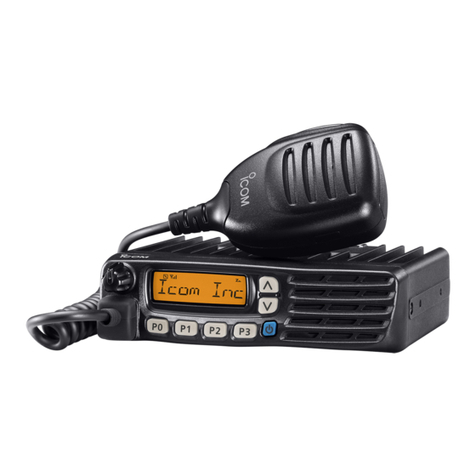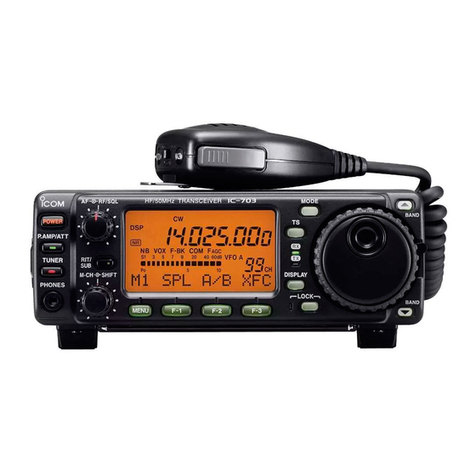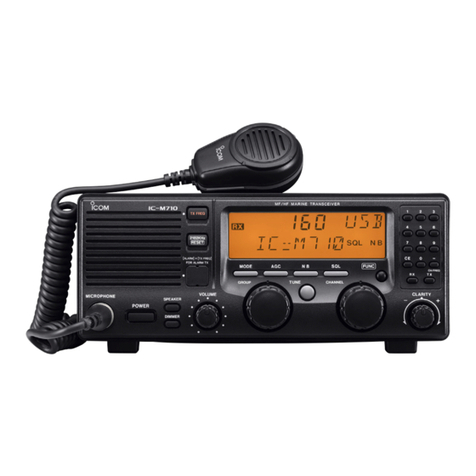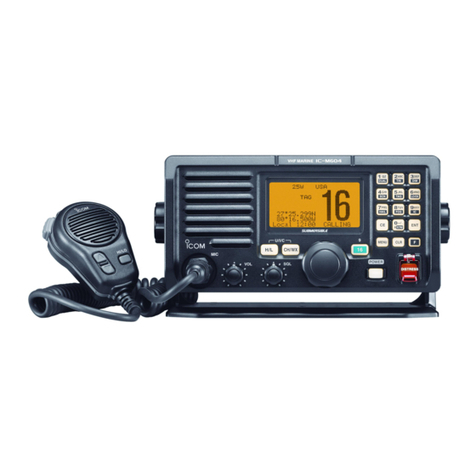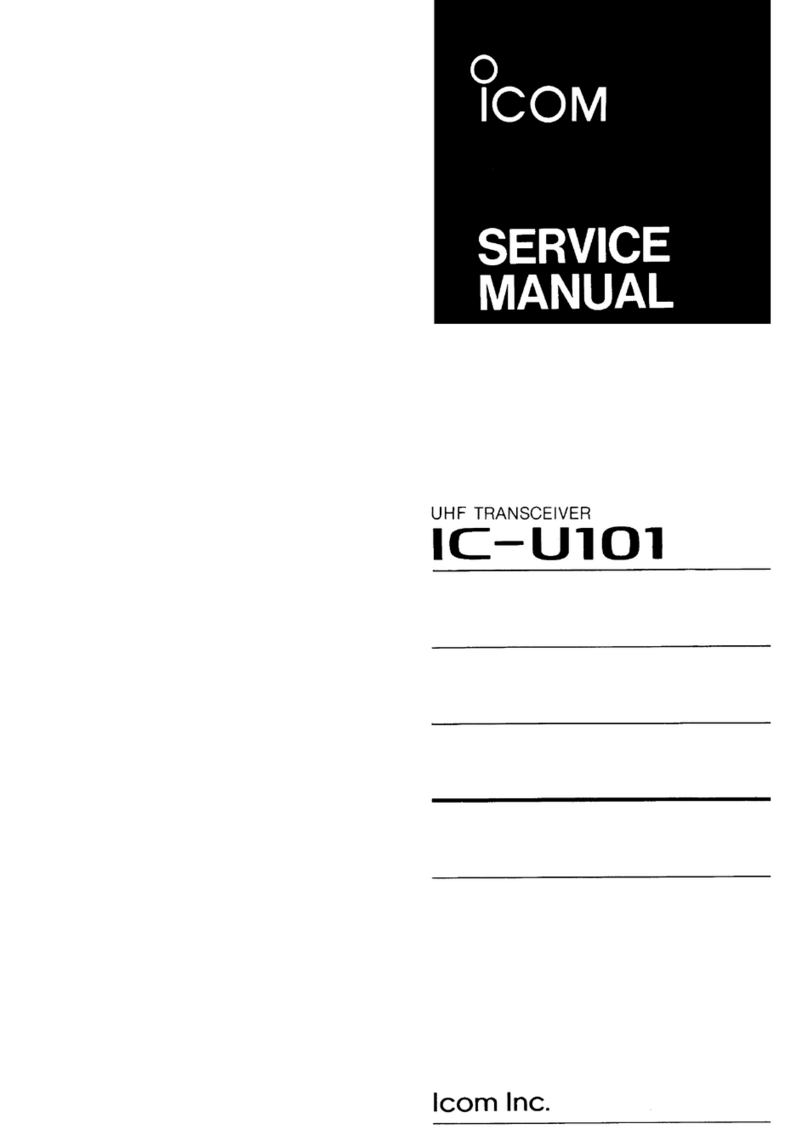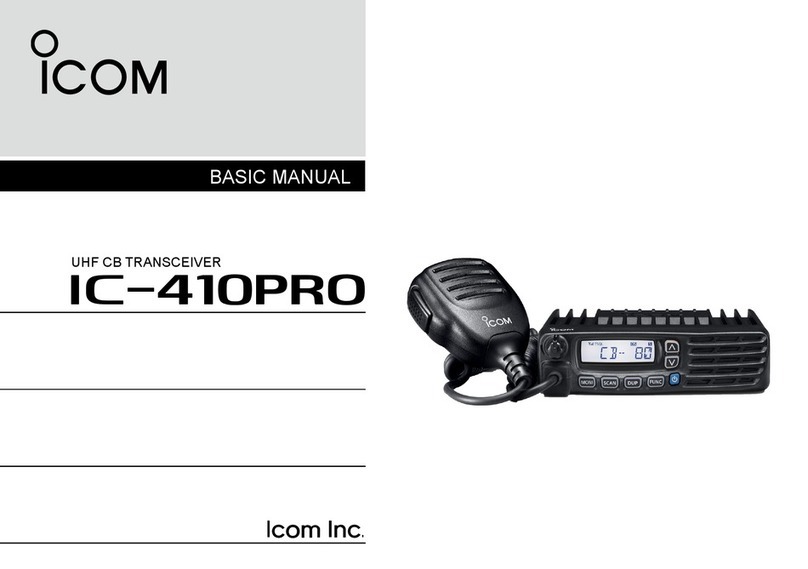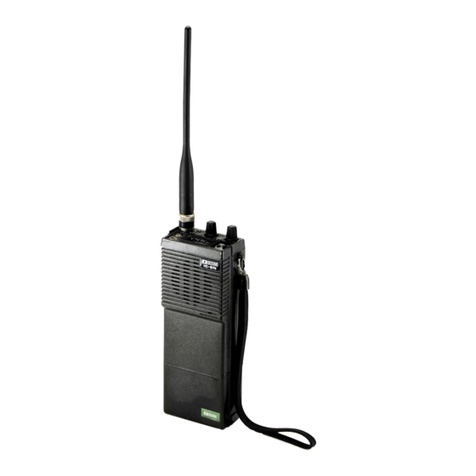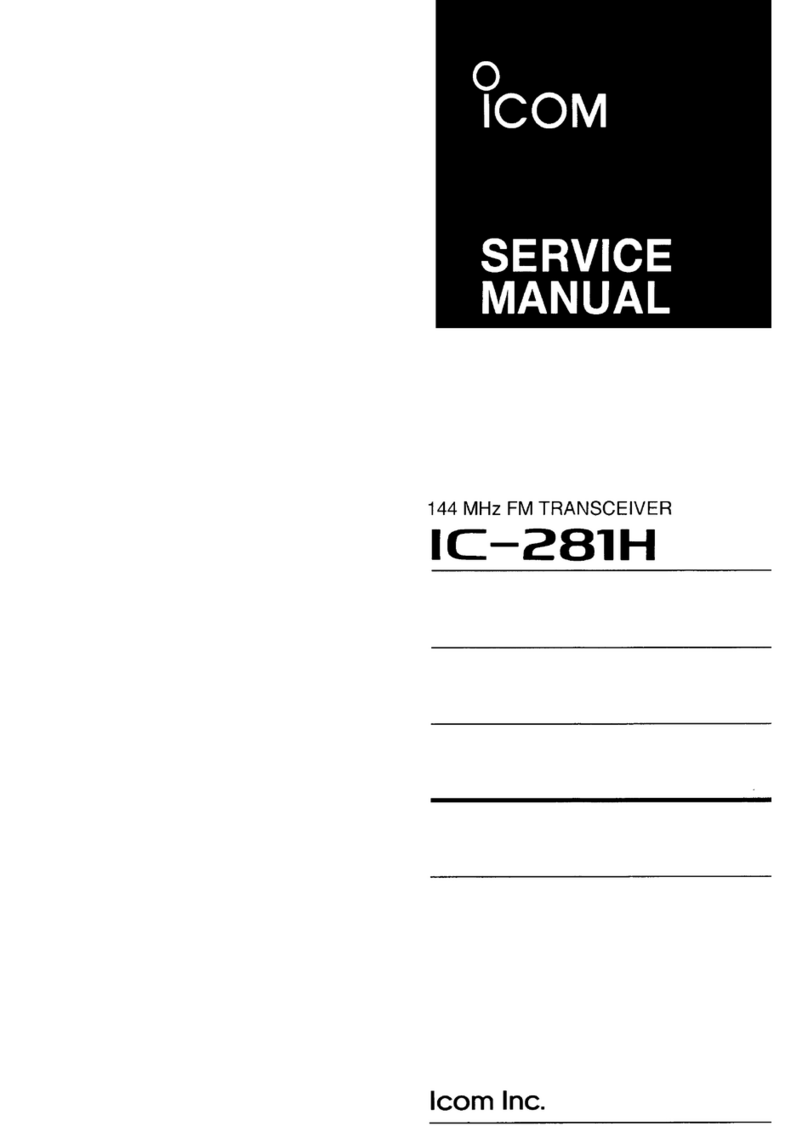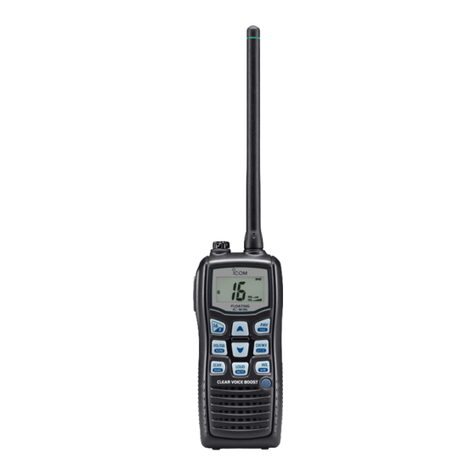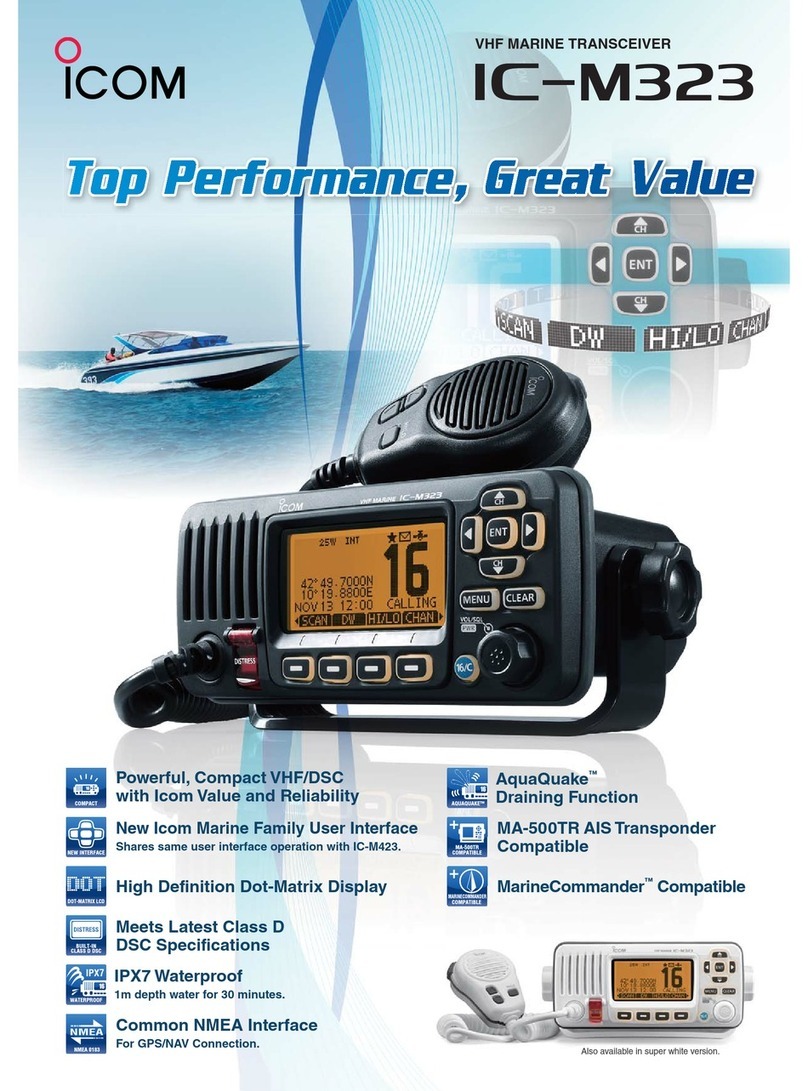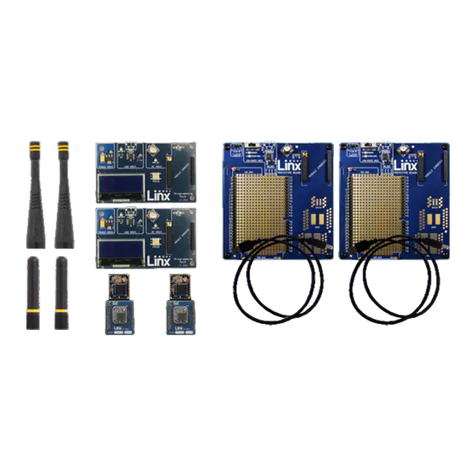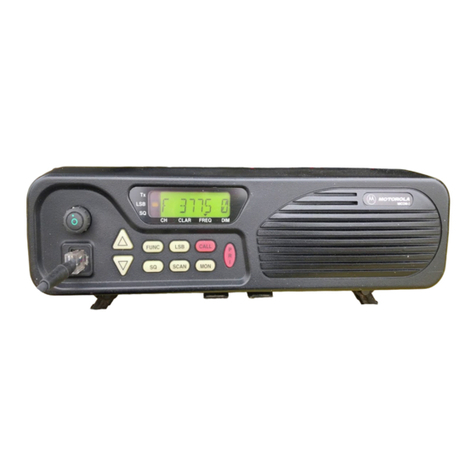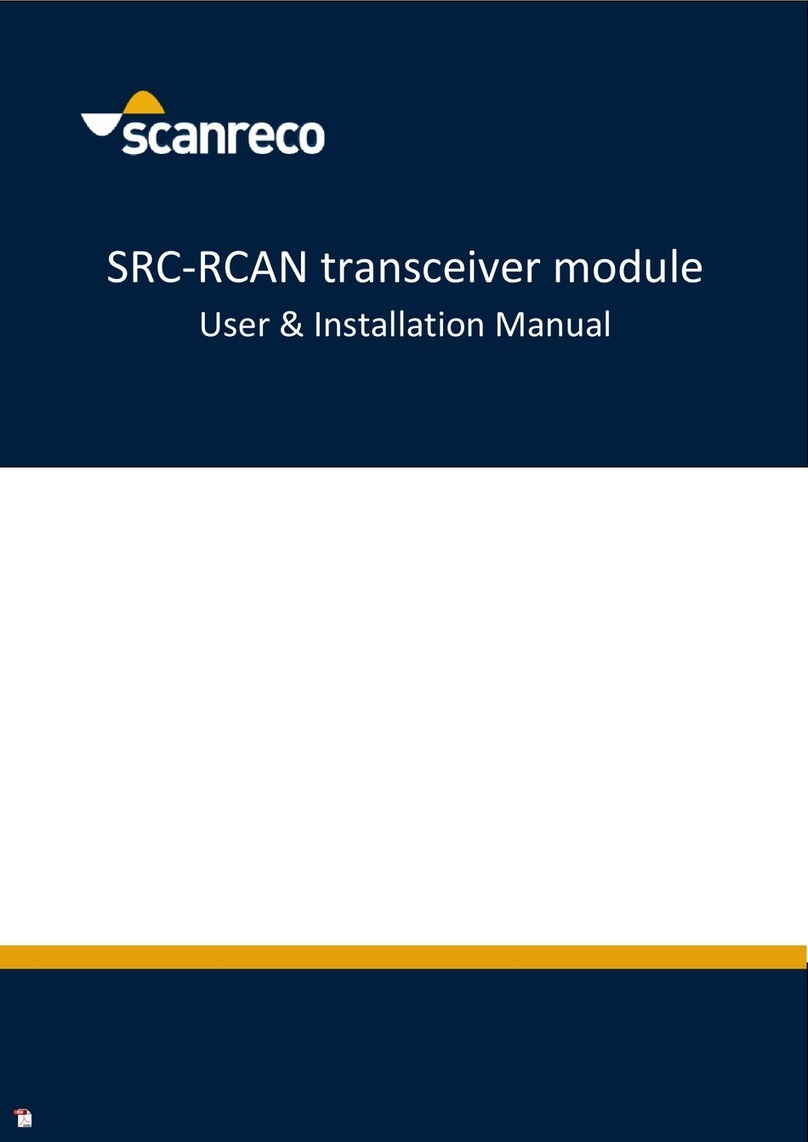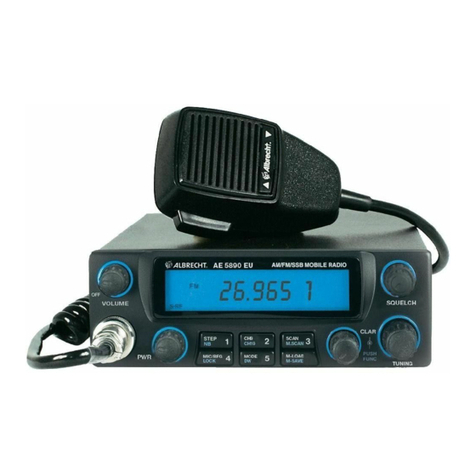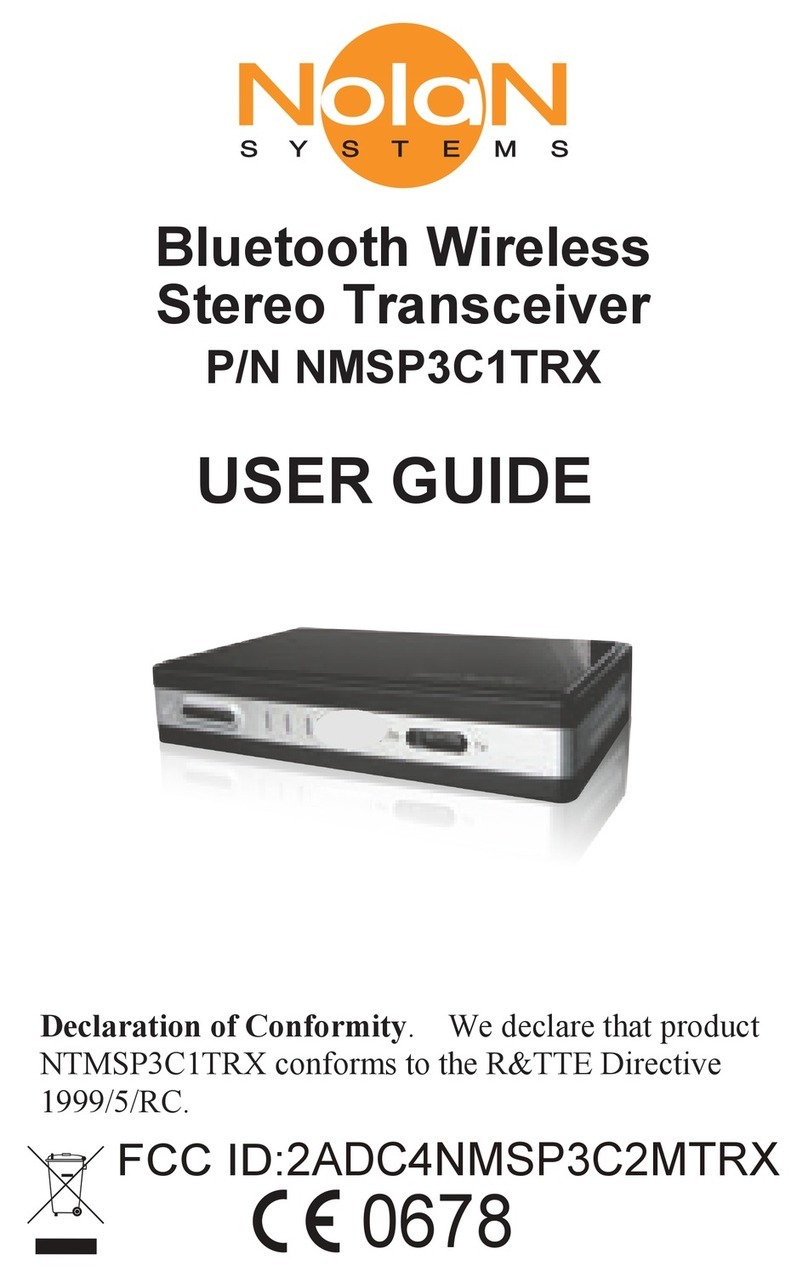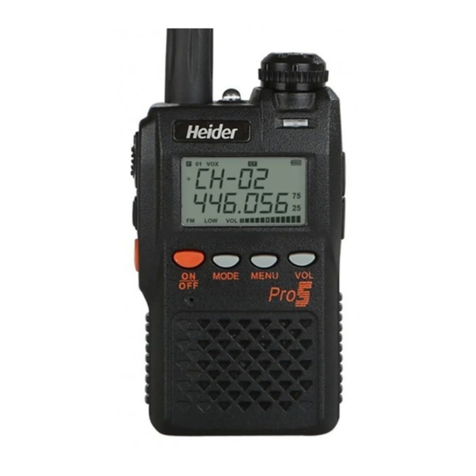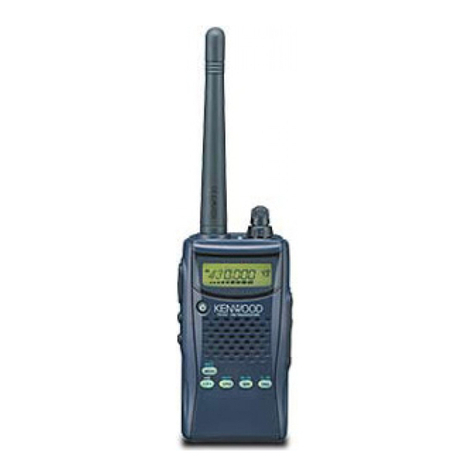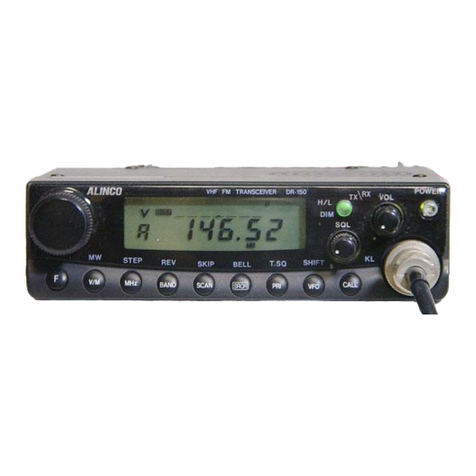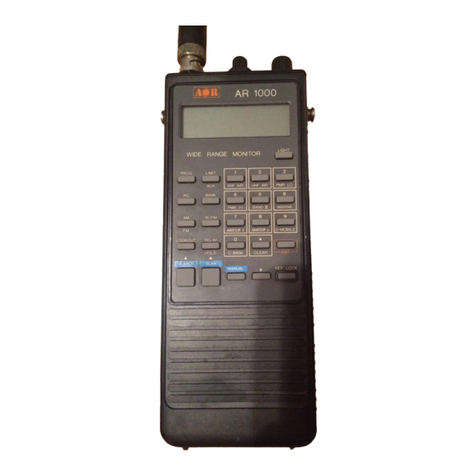Icom IC-M73 User manual

INSTRUCTION MANUAL
iM73
VHF MARINE TRANSCEIVER
This device complies with Part 15 of the FCC Rules. Opera-
tion is subject to the condition that this device does not cause
harmful interference.
iM73EURO
IC-M73 IC-M73EURO
(These transceivers use the FA-S64V)

i
FOREWORD
Thank you for purchasing this Icom product. The IC-M73/IC-
M73EURO VHF MARINE TRANSCEIVER is designed and built
with Icom’s state of the art technology and craftsmanship.
With proper care, this product should provide you with years
of trouble-free operation.
IMPORTANT
READ ALL INSTRUCTIONS carefully and completely
before using the transceiver.
SAVE THIS INSTRUCTION MANUAL — This in-
struction manual contains important operating instructions
for the IC-M73/IC-M73EURO.
EXPLICIT DEFINITIONS
WORD DEFINITION
RDANGER! Personal death, serious injury or an ex-
plosion may occur.
RWARNING! Personal injury, fire hazard or electric
shock may occur.
CAUTION Equipment damage may occur.
NOTE If disregarded, inconvenience only.No risk
of personal injury, fire or electric shock.
FEATURES
Submersible construction
Built tough to withstand the punishing marine environ-
ment, the IC-M73/IC-M73EURO’s submersible construc-
tion meets IPX8 ratings of the International Standard IEC
60529 (2001).
In addition, the speaker grill structure with a water self-
draining Aquaquake function is helpful for easily removing
rain or seawater.
Dualwatch and Tri-watch functions
Convenient functions that allow you to monitor the distress
channel (Ch 16) while receiving one other channel of your
choice (Dualwatch), or while receiving one other channel
of your choice and the Call channel (Tri-watch*). See page
16 for details.
* May not be available depending on the transceiver version.
Voice recorder function
IC-M73/IC-M73EURO has a voice recorder function* which
can automatically, or manually, record the received signal.
The automatic (60 seconds) and manual (30 seconds) re-
cordings are recorded separately into memory in the trans-
ceiver.
* May not be available depending on the transceiver version.
Bass booster function
The TX/RX bass booster functions* boosts the frequen-
cies to increase the bass level, if desired.
* May not be available depending on the transceiver version.

ii
RDANGER! NEVER short the terminals of the battery
pack.
RDANGER! Use and charge only specified Icom battery
packs with Icom radios or Icom chargers.Only Icom battery packs
are tested and approved for use with Icom radios or charged with
Icom chargers. Using third-party or counterfeit battery packs or
chargers may cause smoke, fire, or cause the battery to burst.
RWARNING! NEVER connect the transceiver to an AC
outlet. This may pose a fire hazard or result in an electric shock.
RWARNING! NEVER hold the transceiver so that the an-
tenna is closer than 2.5 cm (1 inch) from exposed parts of the
body, especially the face or eyes, while transmitting. The trans-
ceiver will perform best if the microphone is 5 to 10 cm (2 to 4
inches) away from the lips and the transceiver is vertical.
CAUTION: NEVER connect the transceiver to a power
source other than the products specified by Icom. Such a connec-
tion will ruin the transceiver.
CAUTION: MAKE SURE the flexible antenna and bat-
tery pack are securely attached to the transceiver, and that the
antenna and battery pack are dry before attachment. Exposing
the inside of the transceiver to water will result in serious damage
to the transceiver.
BE CAREFUL! The transceiver meets IPX8 requirements
for waterproof protection. However, once the transceiver has
been dropped, waterproof protection cannot be guaranteed be-
cause of possible damage to the transceiver's case or the water-
proof seal.
DO NOT use or place the transceiver in direct sunlight or in
areas with temperatures below –20°C (–4°F) or above +60°C
(+140°F) for the EXP/USA versions, below –15°C (+5°F) or
above +55°C (+131°F) for the CHN/EUR/FRG/HOL/UK versions,
and below –10°C (+14°F) or above +55°C (+131°F) for the AUS
versions.
DO NOT use harsh solvents such as benzine or alcohol when
cleaning, as they will damage the transceiver surfaces.
DO NOT push [PTT] when not actually intending to transmit.
DO NOT modify the transceiver.The transceiver warranty does
not cover any problems caused by unauthorized modification.
DO NOT operate the transceiver near unshielded electrical
blasting caps or in an explosive atmosphere.
KEEP the transceiver out of the reach of children.
KEEP the transceiver at least 0.9 meter (3.0 feet) away from
your vessel’s magnetic navigation compass.
PRECAUTIONS
Icom, Icom Inc. and the Icom logo are registered trademarks of Icom
Incorporated (Japan) in Japan, the United States, the United Kingdom,
Germany, France, Spain, Russia and/or other countries.

iii
RADIO OPERATOR WARNING
Your Icom radio generates RF electromagnetic energy during
transmit mode. This radio is designed for and classified as
“General Population Use” in an uncontrolled environment.
This radio has been evaluated for compliance at the distance
of 2.5 cm (1 inch) with the FCC and IC RF exposure limits for
“
General Population Use.
” In addition, your Icom radio com-
plies with the following Standards and Guidelines with regard
to RF energy and electromagnetic energy levels and evalua-
tion of such levels for exposure to humans:
s&##/%4"ULLETIN%DITION3UPPLEMENT#%VALUATING#OMPLI-
ance with FCC Guidelines for Human Exposure to Radio Frequency
Electromagnetic Fields.
s!MERICAN.ATIONAL3TANDARDS)NSTITUTE#)%%%3TANDARD
for Safety Levels with Respect to Human Exposure to Radio Frequency
Electromagnetic Fields, 3 kHz to 300 GHz.
s!MERICAN.ATIONAL3TANDARDS)NSTITUTE#)%%%2ECOM-
mended Practice for the Measurement of Potentially Hazardous Electro-
magnetic Fields– RF and Microwave.
s4HEFOLLOWINGACCESSORIESAREAUTHORIZEDFORUSEWITHTHISPRODUCT5SEOF
accessories other than those specified may result in RF exposure levels
exceeding the FCC
and IC
requirements for wireless RF exposure.; Belt
Clip (MB-103), Rechargeable Li-ion Battery Pack (BP-245H).
To ensure that your expose to RF electromagnetic en-
ergy is within the FCC
and IC
allowable limits for general
population use, always adhere to the following guide-
lines:
sDO NOT operate the radio without a proper antenna attached, as this
may damaged the radio and may also cause you to exceed FCC
and
IC
RF exposure limits. A proper antenna is the antenna supplied with
this radio by the manufacturer or antenna specifically authorized by the
manufacturer for use with this radio.
sDO NOT transmit for more than 50% of total radio use time (“50% duty
cycle”). Transmitting more than 50% of the time can cause FCC
and IC
RF exposure compliance requirements to be exceeded. The radio is
transmitting when the “transmit indicator” appears on the LCD. You can
cause the radio to transmit by pressing the “PTT” switch.
sALWAYS keep the antenna at least 2.5 cm (1 inch) away from the body
when transmitting and only use the Icom belt clip which is listed on page
43 when attaching the radio to your belt, etc., to ensure FCC
and IC
RF
exposure compliance requirements are not exceeded. To provide the re-
cipients of your transmission the best sound quality, hold the antenna at
least 5 cm (2 inches) from your mouth, and slightly off to one side.
The information listed above provides the user with the information needed
to make him or her aware of RF exposure, and what to do to assure that this
radio operates with the FCC
and IC
RF exposure limits of this radio.
Electromagnetic Interference/Compatibility
During transmissions, your Icom radio generates RF energy that can possibly
cause interference with other devices or systems. To avoid such interference,
turn off the radio in areas where signs are posted to do so. DO NOT operate
the transmitter in areas that are sensitive to electromagnetic radiation such as
hospitals, aircraft, and blasting sites.
WARNING
CAUTION

iv
AVERTISSEMENT POUR LES OPÉRATEURS RADIO
Votre radio Icom produit une énergie électromagnétique
de radiofréquences (RF), en mode de transmission. Elle
est conçue pour une «utilisation grand public», dans un
environnement non contrôlé. Cet appareil a été évalué et
jugé conforme, à 2,5 cm, aux limites d'exposition aux RF
de la FCC et d’IC, pour une «utilisation grand public». En
outre, votre radio Icom satisfait les normes et directives
qui suivent en matière de niveaux d'énergie et d'énergie
électromagnétique de RF et d'évaluation de tels niveaux
en ce qui concerne l'exposition humaine :
s3UPPL£MENT # £DITION DU "ULLETIN /%4 DE LA &## i%VALUATING
Compliance with FCC Guidelines for Human Exposure to Radio Frequency
Electromagnetic Fields».
s.ORME DE L!MERICAN .ATIONAL 3TANDARDS )NSTITUTE !.3) )%%% #
1992 sur les niveaux de sécurité compatibles avec l’exposition humaine aux
champs électromagnétiques de radiofréquences (3 kHz à 300 GHz).
s.ORMEDEL!.3))%%%#SURLAM£THODED£VALUATIONRECOMMAN-
dée du champ magnétique potentiellement dangereux des radiofréquences
et des micro-ondes.
s,ES ACCESSOIRES QUI SUIVENT SONT APPROUV£S POUR UNE UTILISATION AVEC CE
produit. L'utilisation d'accessoires autres que ceux précisés peut entraîner
des niveaux d'exposition aux RF supérieures aux limites établies par la FCC
et d’IC en matière d'exposition aux RF sans fil; attache pour ceinture (MB-
103), bloc-piles rechargeable au lithium-ion (BP-245H).
CAUTION
Afin de vous assurer que votre exposition à une
énergie électromagnétique de RF se situe dans
les limites permises par la FCC et d’IC pour une
utilisation grand public, veuillez en tout temps
respecter les directives suivantes :
sNE PAS faire fonctionner la radio sans qu'une antenne appropriée y soit
fixée, car ceci risque d'endommager la radio et causer une exposition
supérieure aux limites établies par la FCC et d’IC. L'antenne appropriée
est celle qui est fournie avec cette radio par le fabricant ou une antenne
spécialement autorisée par le fabricant pour être utilisée avec cette radio.
sNE PAS émettre pendant plus de 50% du temps total d'utilisation de
l'appareil («50% du facteur d'utilisation»). Émettre pendant plus de 50% du
temps total d'utilisation peut causer une exposition aux RF supérieure aux
limites établies par la FCC et d’IC. La radio est en train d’émettre lorsque le
témoin du mode de transmission s'affiche sur l'écran ACL. La radio émettra
si vous appuyez sur le bouton du microphone.
sTOUJOURS tenir l'antenne éloignée d'au moins 2,5 cm de votre corps
au moment d'émettre et utiliser uniquement l'attache pour ceinture Icom
illustrée à la p. 43, lorsque vous attachez la radio à votre ceinture, ou à
autre chose, de façon à vous assurer de ne pas provoquer une exposition
aux RF supérieure aux limites fixées par la FCC et d’IC. Pour offrir à vos
interlocuteurs la meilleure qualité de transmission possible, tenez l'antenne
à au moins 5 cm de votre bouche et légèrement de côté.
Les renseignements ci-dessus fournissent à l'utilisateur toute l'information
nécessaire sur l'exposition aux RF et sur ce qu'il faut faire pour assurer que
cette radio fonctionne en respectant les limites d'exposition aux RF établies
par la FCC et d’IC.
Interférence électromagnétique et compatibilité
En mode de transmission, votre radio Icom produit de l'énergie de RF qui
peut provoquer des interférences avec d'autres appareils ou systèmes. Pour
éviter de telles interférences, mettez la radio hors tension dans les secteurs
où une signalisation l’exige. NE PAS faire fonctionner l'émetteur dans des
secteurs sensibles au rayonnement électromagnétique tels que les hôpitaux,
les aéronefs et les sites de dynamitage.
AVERTISSEMENT
MISE EN GARDE

v
COUNTRY CODE LIST
s)3/
Country Codes Country Codes
1
2
3
4
5
6
7
8
9
10
11
12
13
14
15
16
17
Austria
Belgium
Bulgaria
Croatia
Czech Republic
Cyprus
Denmark
Estonia
Finland
France
Germany
Greece
Hungary
Iceland
Ireland
Italy
Latvia
AT
BE
BG
HR
CZ
CY
DK
EE
FI
FR
DE
GR
HU
IS
IE
IT
LV
18
19
20
21
22
23
24
25
26
27
28
29
30
31
32
33
Liechtenstein
Lithuania
Luxembourg
Malta
Netherlands
Norway
Poland
Portugal
Romania
Slovakia
Slovenia
Spain
Sweden
Switzerland
Turkey
United Kingdom
LI
LT
LU
MT
NL
NO
PL
PT
RO
SK
SI
ES
SE
CH
TR
GB
FOR CLASS A UNINTENTIONAL RADIATORS
This equipment has been tested and found to comply with the
limits for a Class A digital device, pursuant to part 15 of the
FCC Rules. These limits are designed to provide reasonable
protection against harmful interference when the equipment
is operated in a commercial environment. This equipment
generates, uses, and can radiate radio frequency energy
and, if not installed and used in accordance with the instruc-
tion manual, may cause harmful interference to radio commu-
nications. Operation of this equipment in a residential area is
likely to cause harmful interference in which case the user will
be required to correct the interference at his own expense.
CAUTION: Changes or modifications to this device, not ex-
pressly approved by Icom Inc., could void your authority to
operate this device under FCC regulations.
FCC INFORMATION

vi
IN CASE OF EMERGENCY
If your vessel requires assistance, contact other vessels and
the Coast Guard by sending a distress call on Channel 16.
MUSING CHANNEL 16
DISTRESS CALL PROCEDURE
1. “MAYDAY MAYDAY MAYDAY.”
2. “THIS IS ...........................” (name of vessel)
3. Say your call sign or other indication of the
vessel.
4. “LOCATED AT ..................... ” (your position)
5. State the nature of the distress and
assistance required.
6. Give any other information which might
facilitate the rescue.
RECOMMENDATION
CLEAN THE TRANSCEIVER THOROUGHLY WITH FRESH
WATER after exposure to saltwater, and dry it before opera-
tion. Otherwise, the transceiver’s keys, switches and control-
lers may become inoperable due to salt crystallization.
NOTE: DO NOT wash the transceiver in water if there is any
reason to suspect the waterproofing may not be effective.
For example, in cases where the transceiver/battery pack is
cracked or broken, or has been dropped, or when the battery
pack is detached from the transceiver.

vii
TABLE OF CONTENTS
FOREWORD ..................................................................................... i
IMPORTANT...................................................................................... i
EXPLICIT DEFINITIONS................................................................... i
FEATURES........................................................................................ i
PRECAUTIONS................................................................................ ii
RADIO OPERATOR WARNING ...................................................... iii
AVERTISSEMENT POUR LES OPÉRATEURS RADIO.................. iv
FCC INFORMATION ........................................................................ v
COUNTRY CODE LIST.................................................................... v
IN CASE OF EMERGENCY............................................................ vi
RECOMMENDATION ...................................................................... vi
TABLE OF CONTENTS.................................................................. vii
OPERATING RULES ..................................................................
2 SUPPLIED ACCESSORIES AND ATTACHMENTS ...............2n
NSupplied accessories...............................................................2
NAttachments.............................................................................2
PANEL DESCRIPTION ........................................................... 4–7
NFront, top and side panels .......................................................4
NFunction display.......................................................................6
4 BASIC OPERATION .............................................................8n
NChannel selection ....................................................................8
NReceiving and transmitting ....................................................11
NCall channel programming.....................................................12
NLock function..........................................................................12
NMonitor function .....................................................................12
NAdjusting the squelch level ....................................................13
NAquaQuake water draining function.......................................13
5 SCAN OPERATION (Except for the Dutch version)............4n
NScan types.............................................................................14
NSetting Favorite channels ......................................................15
NStarting a scan.......................................................................15
DUALWATCH/TRI-WATCH .......................................................
NDescription.............................................................................16
NOperation...............................................................................16
7 FUNCTION MODE OPERATION ........................................7–24
NAbout the function mode........................................................17
NManual recording function (Depending on versions) .............18
N
Automatic recording function (Depending on versions)
.............19
NPlay back function (Depending on versions)..........................20
NChannel naming function.......................................................21
NOpening comment entry function...........................................22
NATIS code programming
(For only the Dutch and German versions)
............................ 23
NBacklight function...................................................................24
8 SET MODE..........................................................................25n
NSET mode programming........................................................25
NSET mode items ....................................................................26
9 BATTERY CHARGING .......................................................n
NBattery cautions.....................................................................31
NSupplied battery charger .......................................................33
NOptional battery chargers ......................................................34
OPTIONAL SWIVEL BELT CLIP..............................................5
NAttaching................................................................................35
NDetaching...............................................................................35
OPTIONAL SPEAKER-MICROPHONE....................................
NHM-167 descriptions..............................................................36
NAttaching................................................................................36
TROUBLESHOOTING ..............................................................7
SPECIFICATIONS...............................................................n
VHF MARINE CHANNEL LIST........................................... 4–42
OPTIONS .................................................................................. 4
INDEX.......................................................................................44–45

1
1
OPERATING RULES
2
4
5
7
8
9
DPriorities
s2EADALL RULES AND REGULATIONSPERTAININGTOCALLPRIORITIES
and keep an up-to-date copy handy. Safety and distress
calls take priority over all others.
s9OUMUSTMONITOR#HANNELWHENYOUARENOTOPERATING
on another channel.
s&ALSEORFRAUDULENTDISTRESSCALLSAREPROHIBITEDUNDERLAW
DPrivacy
s)NFORMATIONOVERHEARDBUTNOTINTENDEDFORYOUCANNOTLAW-
fully be used in any way.
s)NDECENTORPROFANELANGUAGEISPROHIBITED
DRadio licenses
3()034!4)/.,)#%.3%
You may require a current radio station license before using
the transceiver. It is unlawful to operate a ship station which is
not licensed, but required to be.
If required, contact your dealer or the appropriate govern-
ment agency for a Ship-Radiotelephone license application.
This government-issued license states the call sign which is
your craft’s identification for radio purposes.
/0%2!4/23,)#%.3%
A Restricted Radiotelephone Operator Permit is the license
most often held by small vessel radio operators when a radio
is not required for safety purposes.
If required, the Restricted Radiotelephone Operator Permit
must be posted or kept with the operator. If required, only a
licensed radio operator may operate a transceiver.
However, non-licensed individuals may talk over a transceiver
if a licensed operator starts, supervises, ends the call and
makes the necessary log entries.
A current copy of the applicable government rules and regu-
lations is only required to be on hand for vessels in which
a radio telephone is compulsory. However, even if you are
not required to have these on hand it is your responsibility to
be thoroughly acquainted with all pertinent rules and regula-
tions.
NOTE: Even though the transceiver is capable of opera-
tion on VHF marine channels 3, 21, 23, 61, 64, 81, 82 and
83, according to FCC regulations these simplex channels
cannot be lawfully used by the general population in USA
waters.

2
SUPPLIED ACCESSORIES AND ATTACHMENTS
2
NSupplied accessories NAttachments
DFlexible antenna
Connect the supplied flexible
antenna to the antenna connector.
CAUTION:
s.%6%2 carry the transceiver
by holding the antenna.
s4RANSMITTINGWITHOUTANANTENNA
may damage the transceiver.
DHandstrap
Pass the handstrap through the
loop on the top corner of the
transceiver, as illustrated to the
left. This facilitates carrying the
transceiver.
Flexible antenna*
Cigarette lighter cable*
Handstrap Battery Charger
(with two screws)
Belt clip
(with two screws)
Li-ion battery pack
AC adapter*
* Not supplied or different type may be supplied depending on the
transceiver version.

3
2
SUPPLIED ACCESSORIES AND ATTACHMENTS
2
4
5
7
8
9
DBattery pack
Attach the battery pack into the transceiver.q
Battery pack
Lock the battery pack with the latch.w
Latch
CAUTION:
NEVER remove or attach the battery pack when the trans-
ceiver is wet or soiled.This may result in water or dust get-
ting into the transceiver and battery pack, and may result
in them being damaged.
Be careful! The latch is tightly locked, so use caution when
releasing it. DO NOT use your finger nail. Use the edge of
a coin or screwdriver tip to carefully release it.
DBelt clip
Attach the belt clip to the transceiver.
Supplied screws

4
PANEL DESCRIPTION
3
NFront, top and side panels
q
w
e
y
t
r
Microphone
!2
!1
!0
o
u
i
Speaker
Function
display (p. 6)
qVOLUME CONTROL [VOL]
Turns ON power and adjusts the audio level.
wPTT SWITCH [PTT]
Hold down to transmit; release to receive.
e MONITOR KEY []
s-ANUALLYOPENSTHESQUELCHTOMONITORTHECHANNELWHILE
held down. (p. 12)
s0USHTHISSWITCHTHENADJUSTTHESQUELCHLEVELWITH;Y]/
[Z]. (p. 13)
s7HILEHOLDINGDOWNTHISSWITCHTURNTHE/.POWERTO
enter the SET mode. (p. 25)
r#(!..%,+%9;#=
s3ELECTS#HANNELWHENPUSHEDP
s
Selects the Call channel when pushed for 1 second.
(p. 8)
s
Enters the Call channel write mode when the Call channel
is selected and this key is held down for 3 seconds. (p. 12)
tFUNCTION KEY [F]
s%NTERSTHE&UNCTIONMODEWHENPUSHEDP
s4HE!QUA1UAKEFUNCTIONISACTIVATEDWHENHELDDOWNFOR
1 second. (p. 13)
s7HILEHOLDINGDOWNTHISKEYTURN/.THEPOWERTOENTER
the recording counter mode.

5
3
PANEL DESCRIPTION
2
4
5
7
8
9
y3#!.+%9;3#!.s$5!,=
s3TARTSANDSTOPSNORMALORPRIORITYSCANWHENPUSHED
(pp. 14, 15)
s%NTERSTHE7ATCHMODEWHENHELDDOWNFORSECOND
(p. 16)
uCHANNEL/WEATHER CHANNEL KEY
;#(78s5)#=)#-;#(=)#%52/
s3ELECTSANDTOGGLESTHEREGULARCHANNELSANDWEATHER
channel* when pushed. (pp. 9, 10)
s3ELECTS THE 53! )NTERNATIONAL #ANADIAN OR !4)3
channel group* when held down for 1 second. (p. 9)
- The function display shows which channel group is
active.
s0USHTORETURNTOTHEDISPLAYBEFOREYOUSELECTEDTHE
channel when the priority channel or the Call channel is
selected.
* Selectable contents differ depending on the transceiver version.
NOTE: ;#(78s5)#= and [CH] are described as [CH/
78s5)#= in this instruction manual.
iCHANNEL UP/DOWN KEYS [Y]/[Z]
s3ELECTSTHEOPERATINGCHANNELPPn
s3ELECTSTHE3%4MODEOPTIONOFTHEITEMP
s
Selects the SET mode item when pushed along with []
.
(p. 25)
s#HECKS &AVORITE 4!' CHANNELS OR CHANGES THE
scanning direction during a scan. (p. 15)
s3ELECTSTHE&UNCTIONMODEITEMP
o42!.3-)40/7%2,/#++%9;(,s,/#+=
s3ELECTSHIGHMIDDLEORLOWPOWERWHENPUSHEDP
s4OGGLESTHELOCKFUNCTION/./&&WHENHELDDOWNFOR
second. (p. 12)
!0 &!6/2)4%4!'+%9;&!6s(]
s0USHTHISKEYTOSEQUENTIALLYSELECTTHE&AVORITE4!'
channels, while ignoring untagged channels, in a channel
group. (p. 15)
s(OLDDOWNFORSECONDTO SETORCLEARTHEDISPLAYED
channel as a Favorite (TAG) channel. (p. 15)
s7HILEHOLDINGDOWNTHISKEYTURN/.POWERTOCLEAROR
set all Favorite (TAG) channels in the selected channel
group. (p. 15)
!1 SPEAKER-MICROPHONE CONNECTOR [SP MIC]
Connects the optional external speaker-microphone.
(p. 36)
NOTE: Attach the [SP MIC] cap when the optional
speaker-microphone is not used.
!2 ANTENNA CONNECTOR
Connects the supplied antenna. (p. 2)

6
3PANEL DESCRIPTION
NFunction display
q
e
t
i
r
y
o
u
!0
!2
!3
!5
!4
!6
!7
!1
w
qCHANNEL NUMBER READOUT
s)NDICATESTHESELECTEDOPERATINGCHANNELNUMBER
s)NTHE3%4MODEINDICATESTHESELECTEDVALUE
wFAVORITE CHANNEL ICON (p. 15)
Appears when a Favorite (TAG) channel is selected.
e BATTERY ICON
Indicates remaining battery power.
Indication
Full Middle Low No battery
(Charging required)
Battery level
blinks when the battery is overcharged (or over voltage).
r DUALWATCH/TRI-WATCH ICONS (p. 16)
“DUAL” blinks during dualwatch; “TRI” blinks during tri-
watch.
t DUPLEX ICON (p. 9)
Appears when a duplex channel is selected.
y MONITOR ICON (p. 12)
Appears when the monitor function is activated.
u AUTOMATIC RECORDING ICON (p. 19)
Appears when the automatic recording is activated. This
may not appear depending on the transceiver version.
i RECORDING ICON
Appears while the receiving audio is recording. (pp. 18, 19)
This may not appear depending on the transceiver ver-
sion.
o CHANNEL NAME FIELD
s)NDICATES OR SCROLLS THE OPERATING CHANNEL NAME COMMENT OR
ATIS code*. (pp. 21–23)
*For only the Dutch and Germanversions.
s)NTHE3%4AND&UNCTIONMODEINDICATESORSCROLLSTHESELECTED
item. (pp. 25–30)
s“SCAN 16” is displayed during a Priority scan; “SCAN” appears
during a Normal scan. (p. 15)
!0 LOCK ICON (p. 12)
Appears when the lock function is activated.

7
3
PANEL DESCRIPTION
2
4
5
7
8
9
!1 ATIS ICON (pp. 9, 23)
Appears when the channel group, in which ATIS function
is activated, is selected or while programming an ATIS
code.
s&ORONLYTHE(/,AND&2'VERSIONS
!2 CALL CHANNEL ICON (p. 8)
Appears when the Call channel is selected.
!3 CHANNEL GROUP ICON (p. 9)
“USA” appears when U.S.A.*1; “INT” appears when
International; “CAN” appears when the Canadian*2; “ATIS”
appears when ATIS*3channel group is selected.
*
1Only USA, UK, EXP, CHN and AUS versions.
*
2Only USA, EXP and CHN versions.
*
3Only HOL version.
!
4WEATHER CHANNEL/WEATHER ALERT ICONS* (p. 10)
sh” appears when the Weather channel group is
selected.
sh” appears when the Weather alert function is
activated.
*Selectable on only the USA, EXP, and AUS versions.
!5 TRANSMIT POWER ICONS (p. 11)
sh,/7vAPPEARSWHENLOWPOWERISSELECTED
sh-)$vAPPEARSWHENMIDPOWERISSELECTED
s.OINDICATIONAPPEARSWHENHIGHPOWERISSELECTED
!6 TRANSMIT ICON (p. 11)
Appears during transmit.
!7 BUSY ICON (pp. 11, 12)
Appears when a signal is received, or the squelch opens.

8
BASIC OPERATION
4
NChannel selection
IMPORTANT!: Prior to using the transceiver for the first
time, fully charge the battery pack. This will help maximize
the capability and life of the battery. To avoid damage to
the transceiver, turn OFF the radio while charging.
D#HANNEL
Channel 16 is the distress and safety channel. It is used for
establishing initial contact with another station, and for emer-
gency communications. Channel 16 is automatically moni-
tored during both Dualwatch and Tri-watch. While standing
by, you must monitor Channel 16.
qPush ;#= to select Channel 16.
wPush ;#(78s5)#= to return to the condition before
selecting Channel 16, or push [Y]/[Z]to select the
operating channel.
Push
DCall channel
Each regular channel group has separate leisure-use call
channels. The Call channel is monitored during Tri-watch.
The Call channels can be reprogrammed (p. 12) and may be
used to store your most often-used channels in each channel
group for quick recall.
qHold down ;#= for 1 second to select the Call channel.
sh#!,,vANDTHECALLCHANNELNUMBERAPPEAR
s4HE#ALLCHANNELCANBEREPROGRAMMED3EETHEh#ALLCHANNEL
programming” on page 12 for details.
wPush ;#(78s5)#= to return to the screen before you
selected Call channel, or push [Y]/[Z]to select an
operating channel.
Hold down
for 1 second

9
4
BASIC OPERATION
2
4
5
7
8
9
DU.S.A., International, Canadian and ATIS
channels
The transceiver has U.S.A.*1, International, Canadian*2and
ATIS*3channels.You must select the proper channels for the
operating area.
*1Only USA, UK, EXP, CHN and AUS versions.
*2Only USA, EXP and CHN versions.
*3Only HOL version.
Pushq;#(78s5)#= to select a regular channel.
s)FTHEWEATHERCHANNELAPPEARSPUSH;#(78s5)#= again.
Pushw[Y]/[Z]to select a channel.
sh$50vAPPEARSFORDUPLEXCHANNELS
e To change the channel group, hold down ;#(78s5)#=
for 1 second.
s2EPEATUNTILYOUREACHTHEDESIREDCHANNELGROUP
For U.K. and Australia versions
U.S.A. channelsInternational channels
Hold down
for 1 second
Hold down
for 1 second
Hold down
for 1 second
Hold down
for 1 second
Hold down
for 1 second
For Dutch version
For U.S.A., Export, and China versions
International channels
International channels
U.S.A. channels
ATIS channels
Canadian channels

10
4BASIC OPERATION
DWeather channels
The transceiver has 10 pre-programmed weather channels*.
These are used for monitoring broadcasts from NOAA (Na-
tional Oceanographic and Atmospheric Administration.) The
transceiver can automatically detect a weather alert tone on
the selected weather channel or while scanning.
See the “SET mode items” on page 26 for details.
* For only the USA, EXP, and AUS versions.
Pushq;#(78s5)#= to select the weather channel group.
Pushw[Y]/[Z]to select a weather channel.
Pushe;#(78s5)#= to return to the screen before you
selected the Weather channel group.

11
4
BASIC OPERATION
2
4
5
7
8
9
NReceiving and transmitting
CAUTION: Transmitting without an antenna may damage
the transceiver.
Rotateq[VOL] clockwise to turn ON power.
s!NOPENINGCOMMENTSCROLLSACROSSTHEFUNCTIONDISPLAY
s0USH;#= to skip the opening comment.
Set the volume and squelch level.w
±Push [], and push [Z]to open the squelch.
±Rotate [VOL] to set the volume level.
±Push [], and push [Y]/[Z]to set the squelch level.
Pushe[Y]/[Z]to select the desired channel.
s0USHING;&!6s(] selects only Favorite channels.
- When receiving a signal, the “ ” icon appears while audio is
heard from the speaker.
- Further adjustment of [VOL] may be necessary at this point.
Pushr;(,s,/#+= to select the output power, if necessary.
- “LOW” appears when low power is selected; “MID” appears
when mid power is selected; no indication is displayed when high
power is selected.
- Choose low or mid power to conserve battery power; choose
high power for longer distance communications.
- Some channels are for only low transmission.
t Hold down [PTT] to transmit, and speak at your normal
voice level.
- The appears while transmitting.
- Channel 70 cannot be used for transmission.
Releasey[PTT] to receive.
IMPORTANT: To maximize the readability of your transmit-
ted signal, pause a second after pushing [PTT]. Hold the
microphone 5 to 10 cm (2 to 4 inches) from your mouth, and
speak at your normal voice level.
NOTE: The transceiver has a power save function to con-
serve the battery power. The power save function automati-
cally activates when no signal is received for 5 seconds.
To prevent accidental prolonged transmission, the trans-
ceiver has a time-out timer function*.This timer cuts OFF a
transmission after 5 minutes of continuous transmission.
* For only the USA and AUS versions.
qPower ON
wSet the volume
wSet the squelch
level
wSet the squelch
level
eSelect the
channel
rSet the output
power
tPush to transmit
yRelease to receive
Microphone
Speaker

12
4BASIC OPERATION
12
NCall channel programming
The Call channel key is used to select Channel 9* by default.
However, you can program your most often-used channel in
each channel group for quick recall.
* The channel may differ, depending on the transceiver version.
Hold downq;#(78s5)#= for 1 second several times to
select the desired channel group (USA, INT, CAN, ATIS) to
be programmed.
w Hold down ;#= for 1 second to se-
lect the Call channel.
sh#!,,v AND #ALL CHANNEL NUMBER AP-
pear.
Hold downe;#= again for 3 sec-
onds (until a long beep changes to 2
short beeps) to enter the Call channel
programming mode.
s4HE #ALL CHANNEL NUMBER TO BE PRO-
grammed blinks.
r Push [Y]/[Z]to select the desired
channel.
Pusht;#= to program the displayed
channel as the Call channel.
s4HE#ALLCHANNELNUMBERSTOPSBLINKING
NLock function
This function electronically locks all keys (except for [PTT], [ ]
and ;(,s,/#+=)to prevent accidental channel changes and
function access.
±Push ;(,s,/#+= for 1 second to turn the lock function
ON or OFF.
Hold down
for 1 second
Appears while the loc
k
function is in use.
NMonitor function
The monitor function releases the noise squelch mute to
check the volume level. See page 27 for details of the monitor
switch action.
±Hold down []for 1 second to activate the monitor func-
tion.
sh ” and “ ” appear and audio is heard.
Appears while the
monitor function is
in use.
Hold down
for 1 second
Other manuals for IC-M73
4
This manual suits for next models
1
Table of contents
Other Icom Transceiver manuals

Icom
Icom IC-M502AW User manual

Icom
Icom SPH Series User manual
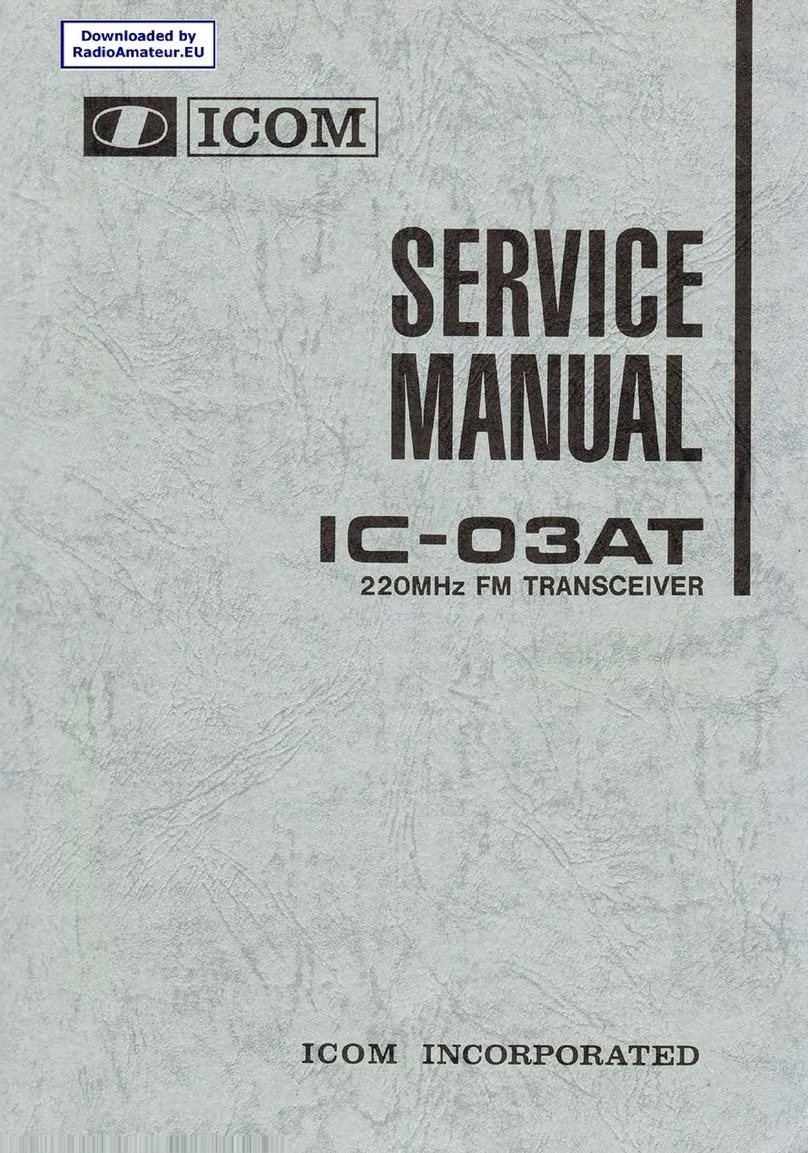
Icom
Icom IC-03AT User manual
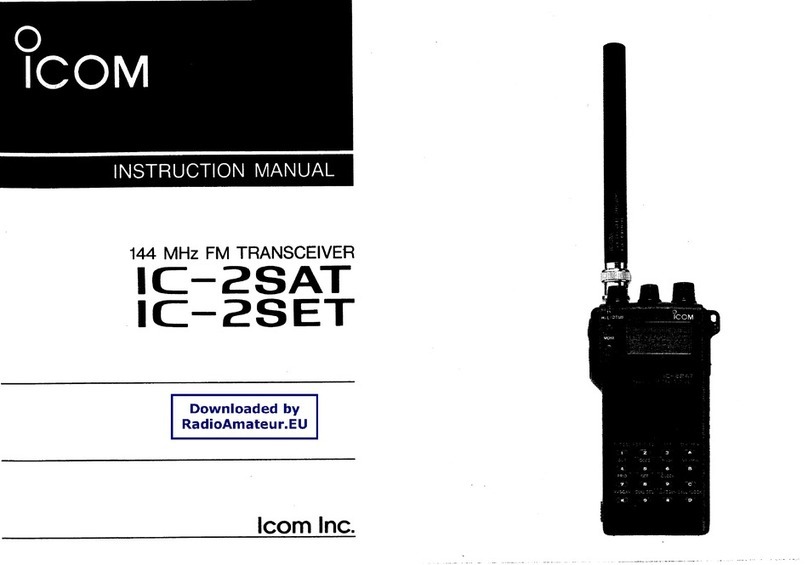
Icom
Icom IC-2SAT User manual
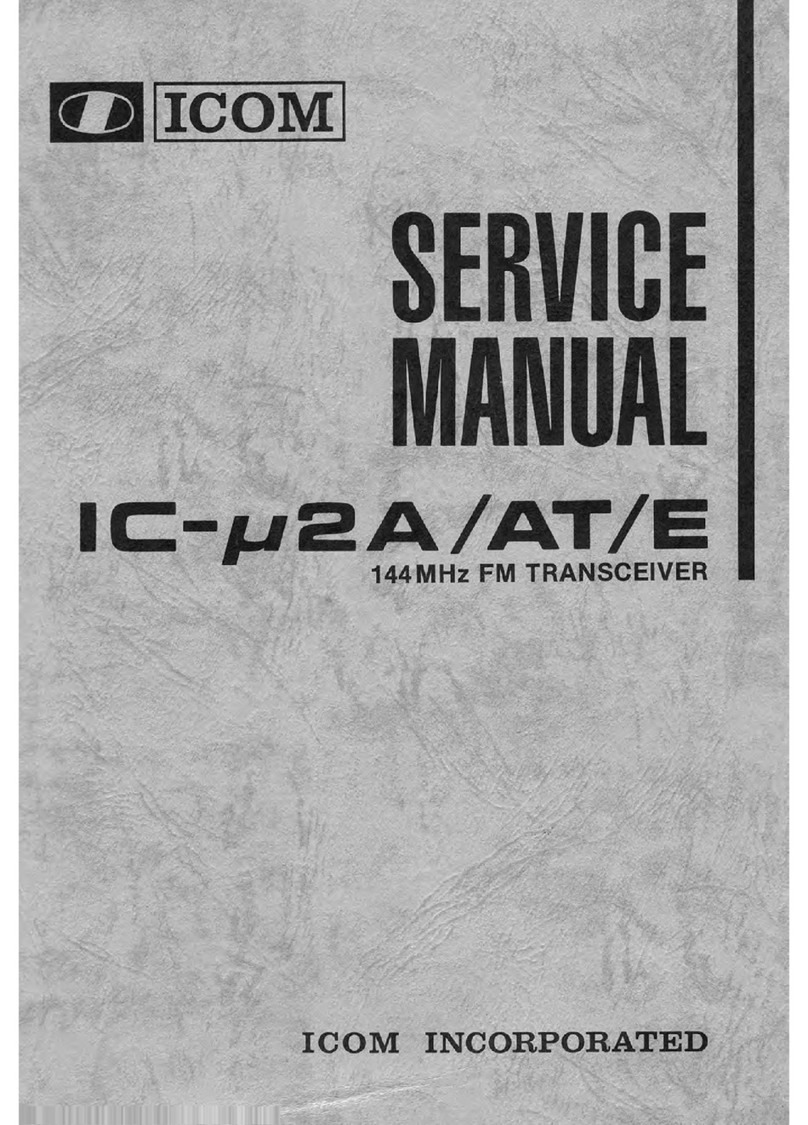
Icom
Icom IC-?2A/AT/E User manual
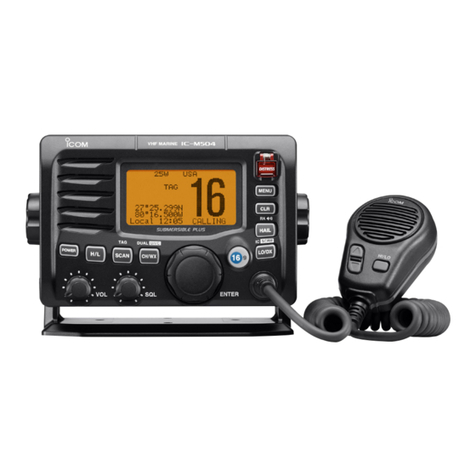
Icom
Icom IC-M504A User manual

Icom
Icom IC-FR4000 Series User manual
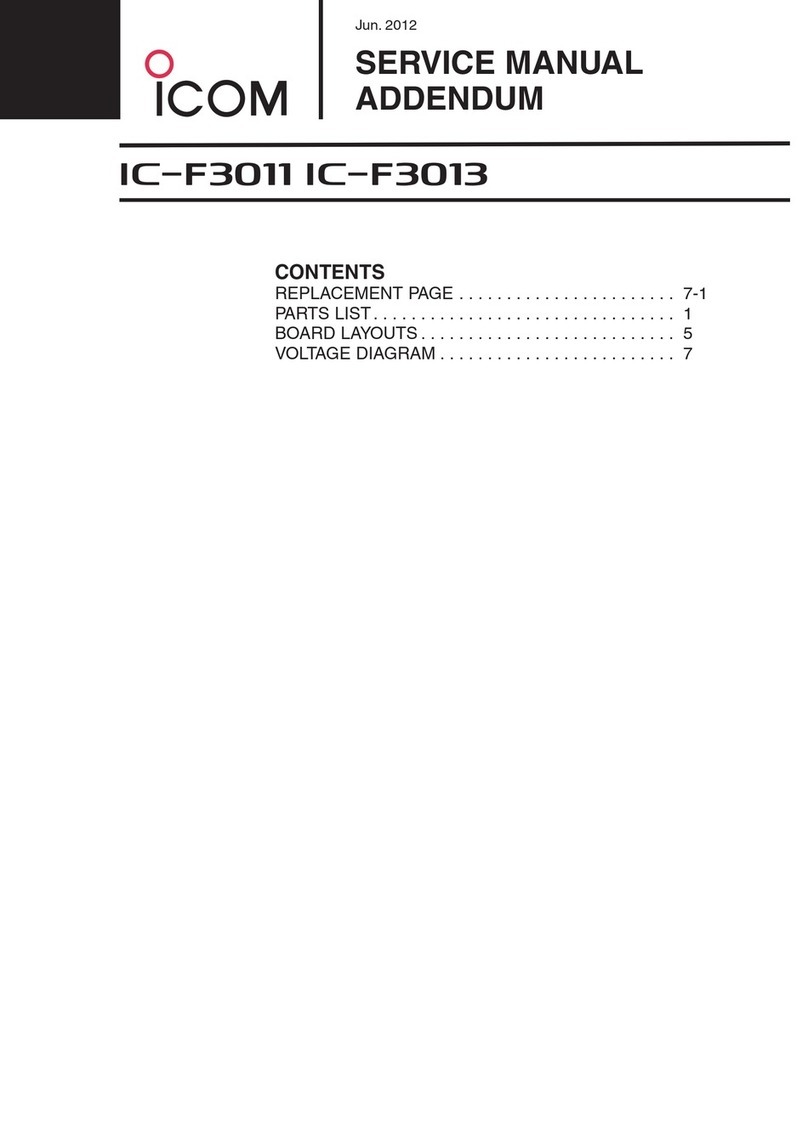
Icom
Icom IC-F3011 Installation and operating instructions
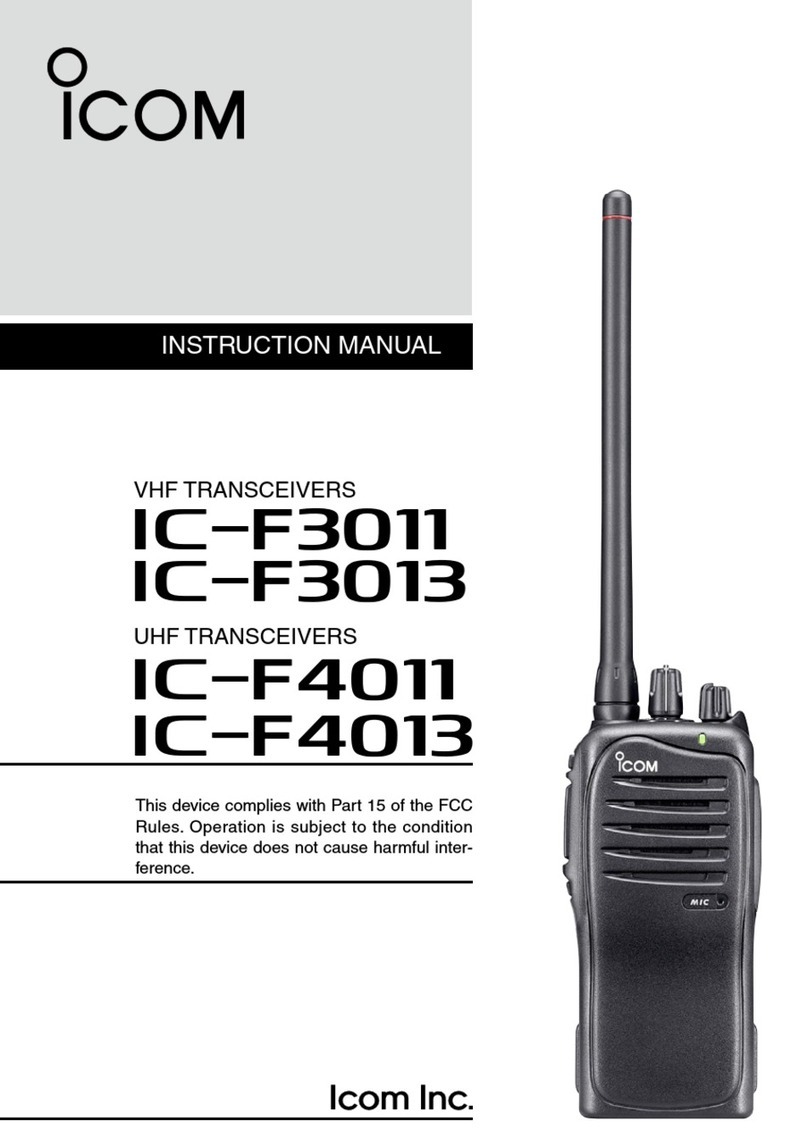
Icom
Icom iF3011 User manual
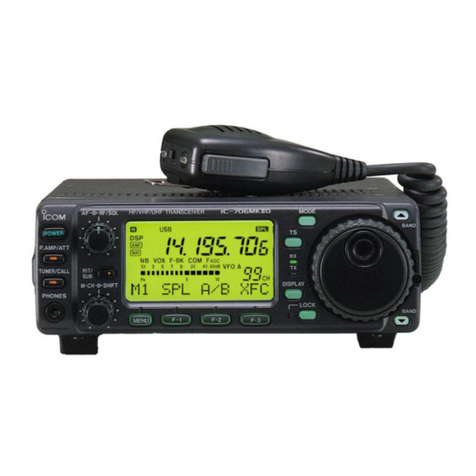
Icom
Icom IC-706MKIIG User manual
Popular Transceiver manuals by other brands

SG Security Communications
SG Security Communications SKYROUTE installation manual
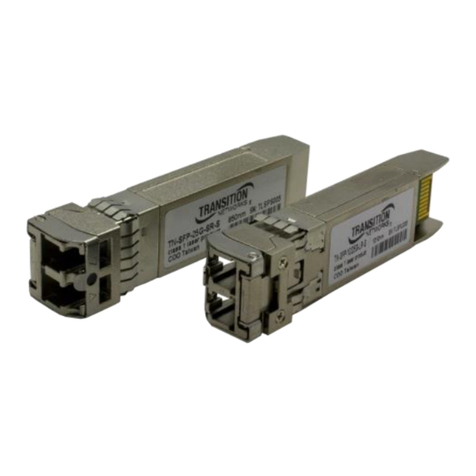
Transition
Transition TN-SFP Series user guide

Vertex Standard
Vertex Standard Spirit VXA-700 operating manual
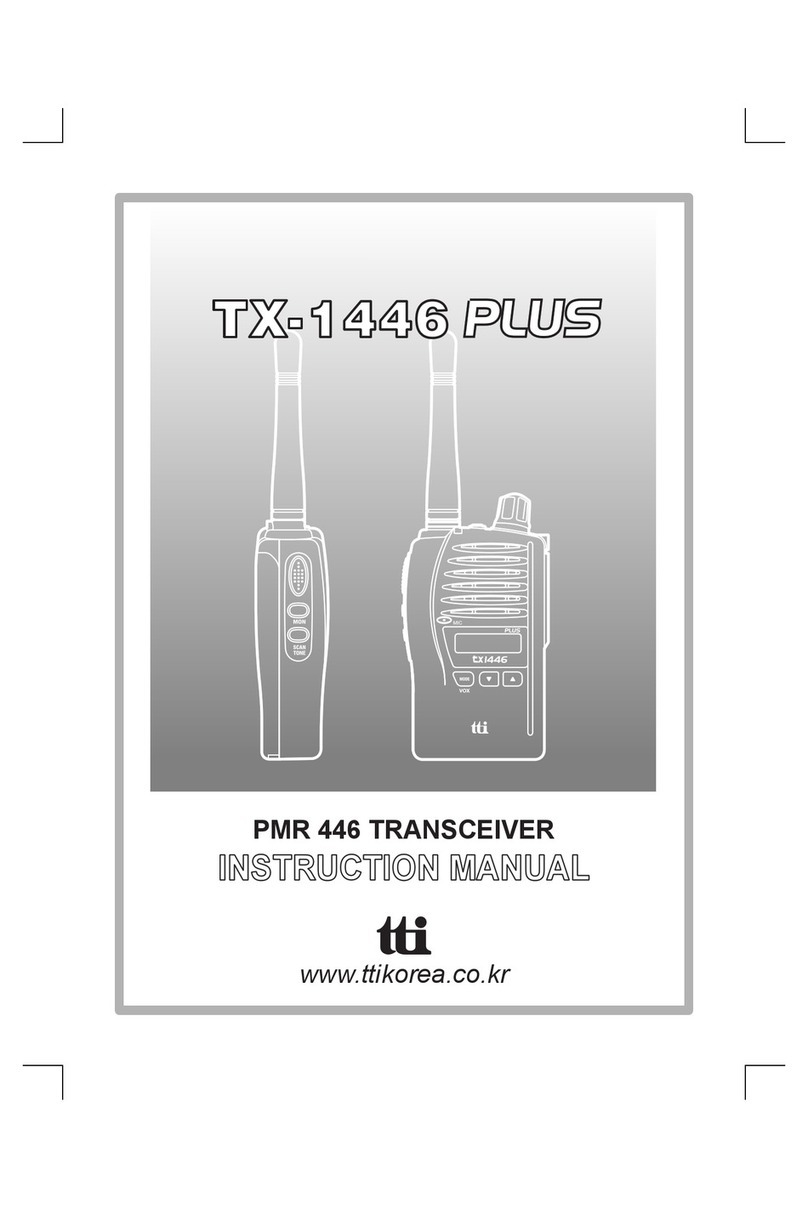
TTikorea
TTikorea TX-1446 PLUS instruction manual
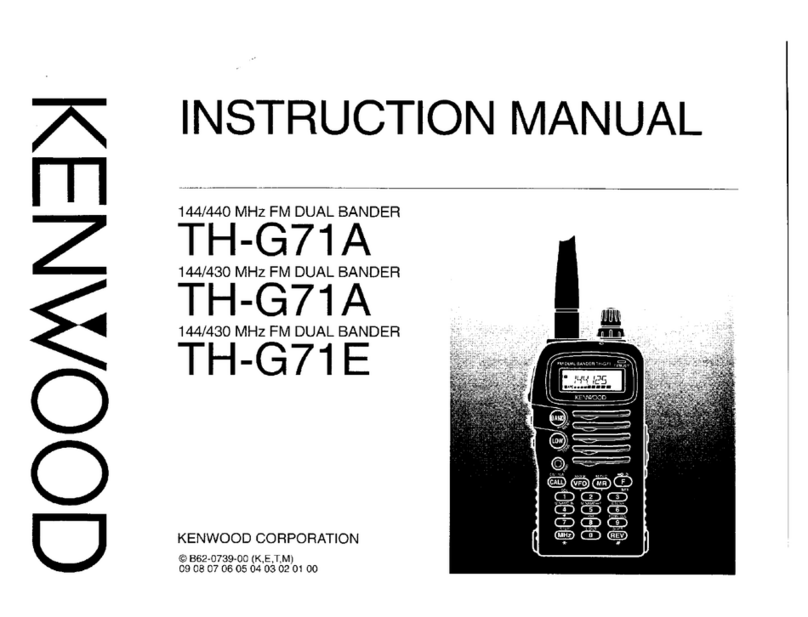
Kenwood
Kenwood TH-G71A instruction manual
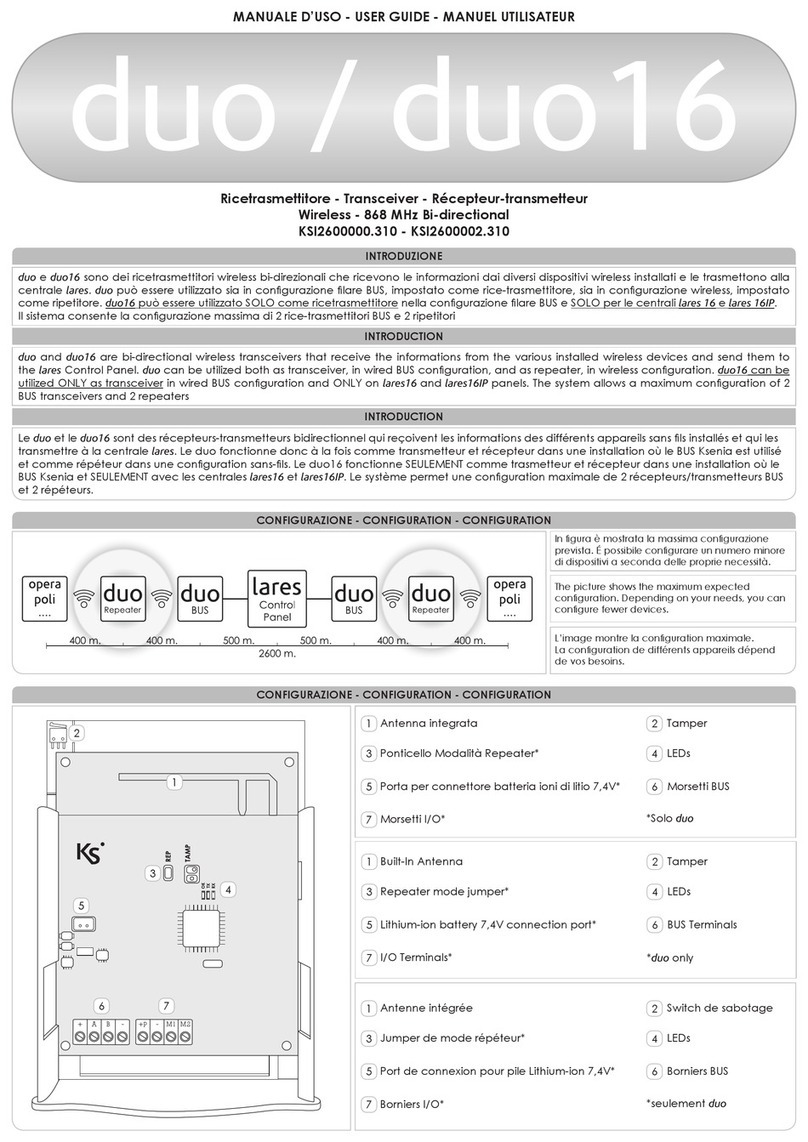
Ksenia
Ksenia duo user guide

